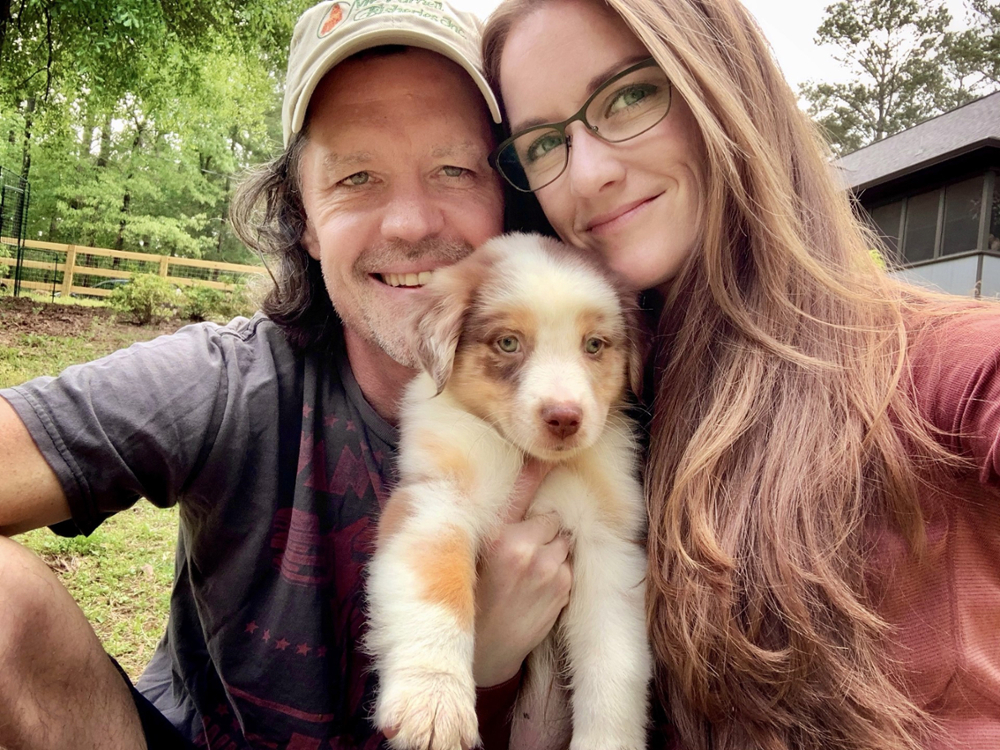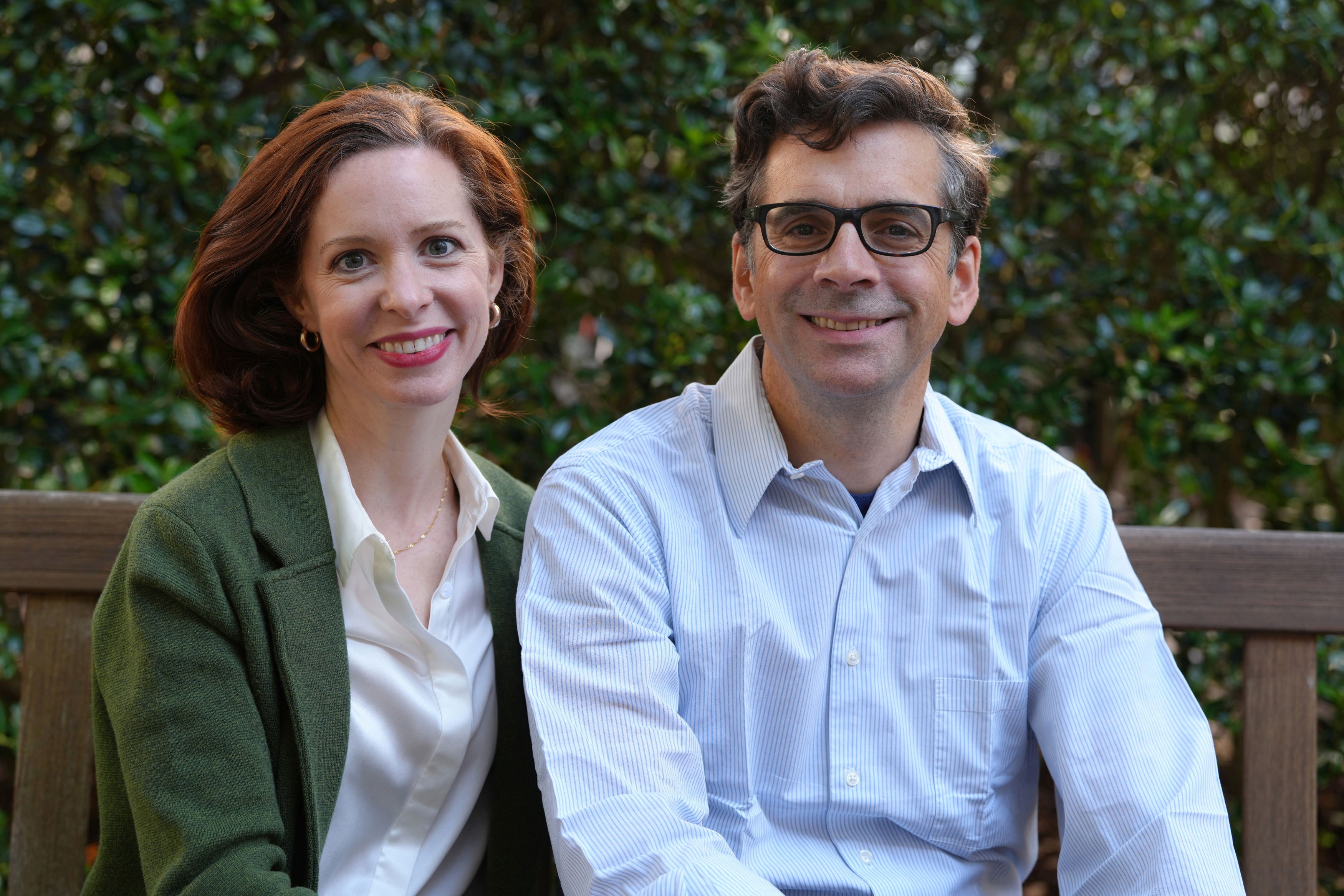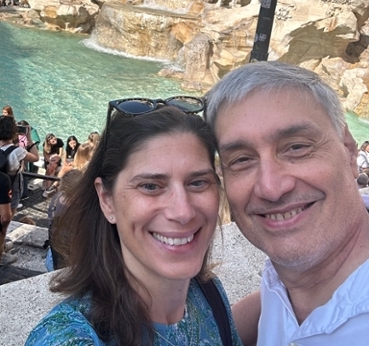While a sterile research laboratory is not necessarily a traditional setting for a “meet-cute,” Emory is home to several co-investigators who will be taking a break from analyzing data and testing samples to celebrate Valentine’s Day together.
Following in the footsteps of Pierre and Marie Curie, these scientific power couples are proving that the best research is produced in pairs.
Aubrey Kelly and Rick Thompson
Meet Aubrey Kelly, an assistant professor of psychology at Emory University, and Rick Thompson, a professor of psychology, neuroscience and behavioral biology at Oxford College of Emory University. Their unique journey from scientific collaborators to life partners is a testament to love, shared passions and serendipity.
Each coming from different backgrounds — Aubrey from San Diego, California, and Rick, interestingly, born at Emory University Hospital and raised in Atlanta — their paths crossed professionally while living in different states, marking the beginning of a long, intermittent scientific collaboration before sparks flew.
Aubrey was working at Cornell University in upstate New York and Rick was splitting his time between Bowdoin College in Maine and the National Science Foundation when they moved past a purely scientific collaboration to a romantic partnership. Aubrey’s move to Emory in 2018 led to a subsequent opportunity for Rick to join Oxford, and the two further solidified their bond.

When Rick Thompson and Aubrey Kelly are not studying the social responses of zebrafish, they love to spend time outdoors.
“It's wonderful to be around Aubrey's positive energy all the time,” says Rick. “She is a talented, dedicated scientist, but also someone who recognizes that she is not defined by that label, and that the world is much larger than the lab.”
Aubrey’s lab studies neural mechanisms of social behavior and grouping behavior in animals while Rick’s lab examines the neural effects of steroids in zebrafish. In recent collaborations, they’ve blended their complementary perspectives to study the impact of testosterone on social behavior in male and female Mongolian gerbils.
Aubrey admires Rick’s thoughtfulness and patience, while Rick values Aubrey’s enthusiasm and balanced perspective on life and work.
“Being in a relationship with a scientist who does something similar makes the science that we do in my lab better. And it helps me grow as a scientist,” says Aubrey. “If I ever have a problem — science-related or not — I know that he’s going to take the time to help me think through every possible angle or outcome or consequence. I think that level of support in a partner is amazing.”
Rachel Hall-Clifford and Gari Clifford
Pick-up lines rarely include, “So, how do you want to make a difference in global health?” but when Rachel Hall and Gari Clifford met in the St. Cross College bar at Oxford University, where Gari was pursuing his doctorate and Rachel her master's, it soon became clear that this was a shared passion.
“We got married in my hometown of Chattanooga, Tennessee, 20 years ago now. Gari was a little overwhelmed by the 600-strong attendance at the ceremony — there’s nothing quite like a big Southern wedding!” Rachel says.

Rachel Hall-Clifford and Gari Clifford work together to develop AI solutions to improve pregnancy outcomes in Guatemalan communities.
“I’ve learned how important it is that you understand how other cultures perceive your intentions,” says Gari, chair of biomedical informatics and a professor of biomedical engineering at Emory School of Medicine. “Health care is a relationship, not a problem to be solved. This is as a true partnership with the midwives, engineers and clinicians of our partner NGO, the Maya Health Alliance.”
“Gari does hardware, informatics and AI, that I could never do, and I guide community engagement and implementation,” says Rachel, a medical anthropologist in the Center for the Study of Human Health and assistant professor in the departments of sociology and global health. “Honestly, having each other to bounce ideas off of and laugh with — when the work is going well and especially when it’s not — is the best part of working together.”
Gari adds, “I think we work together so well because we have congruent skillsets, and a shared goal. We learn what is possible from each other’s expertise in our respective disciplines, what barriers exist and the potential for both human and technology.”
Ann Chahroudi and Guido Silvestri
Cupid’s arrow was nowhere in sight when Guido Silvestri first met Ann Chahroudi. Or maybe it was.
“I was doing research on AIDS at that time,” says Guido, now a professor in the Emory School of Medicine. “She and I sort of collided because she was doing her PhD in a lab of a close collaborator. We were talking about flow cytometry and genes and viruses, the stuff romantic people talk about.”
Romantic enough for two immunologists, anyway.
Ann, who’s also now a professor of pediatrics in the School of Medicine, wanted to work on developing a vaccine that could kill the stubbornly persistent HIV. The two had already contributed to a paper before Silvestri started his own lab at Emory — and before they even met. Out of these circumstances, the chemistry between their two labs sparked a reaction.
More than 20 years, three kids and 50 published papers later, the two Emory faculty members have managed to retain both their scientific and their domestic partnership, driven by their common scientific quest, their mutual respect and chemistry and their continuing ability to complement each other’s strengths. Most importantly, that includes the ability to intuit what the other one is thinking.

Ann Chahroudi and Guido Silvestri takie a break from their research to visit Rome.
“She’s very smart, very organized, a little bossy,” says Guido. “I rely a bit more on leaps and we joke about lateral thinking, but she really helps me be more organized, efficient and straightforward.”
Ann, meanwhile, says her husband helps her retain the big picture amid the daily minutiae of research. “He has always seen the horizon,” she says. “Also where the field is moving. That’s a great advantage.”
Both researchers are affiliated with the Emory National Primate Research Center, where they study the nonhuman primate equivalent of HIV, which Chahroudi says is the best animal model for viral infection.
Meanwhile, the two married researchers manage to pursue independent research agendas even as they continue to collaborate on others. Their oldest daughter is currently a pre-med sophomore at Emory. However, with their two younger kids still at home, dinner table conversations continue to be a nightly ritual, which they manage to keep relatively free from science talk.
“I think they benefited a lot from that,” Ann says. “There’s a lot to talk about other than science. If we’re talking about science, it’s often more about the people in science rather than the concepts after a long day of work. We're talking about other things in life. It goes back to the respect for each other’s intelligence.”

